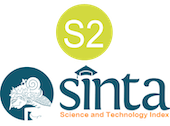Native Mycorrhizal Fungi in Land Contaminated Cr, Co and Cu
Muhammad Akhsan Akib, Andi Nuddin, Retno Prayudyaningsih, Syatrawati Syatrawati, Henny Setiawaty
Abstract
Mycorrhizal fungi that are capable of adapting and resistant to heavy metal contaminated environments have received special attention for phytorhizoremediation researchers. The aim of the study was to explore native mycorrhizal fungi from areas contaminated with heavy metals to be used as starter biological agents in the phytorhizoremediation program. This research was carried out in two phases, i.e. rhizosphere sampling of Polypodium glycyrrhiza, Sumasang sp (local name) and Spathoglottis plicata at coordinates 2O 31'57,6"S and 121O 22'50,7"E. Rhizosphere of Chromolaena odorata, Melastama affine and Nephrolepis exaltata at coordinates 2O 31'53,5"S and 121O 22'35,4"E, Sorowako, Indonesia; While the other phase is isolating and identifying mycorrhizal spores in the Microbiology Laboratory, Research and Development Center for Environment and Forestry in Makassar, Indonesia. The results showed that be discovered three genus of mycorrhizal fungi were able to adapt and resistant in areas contaminated with Cr, Co, and Cu, i.e. 44.44% to 75.86% Acaulospora sp; 9.52% to 44.44% Gigaspora sp, and 3.38% to 19.05% Glomus sp. which could be used as source of inoculum in Phyto-rhizoremediation program. We recommend using native mycorrhizal fungi combined with endemic plant of location to rehabilitation heavy metal contaminated soils.
Keywords
Acaulospora; fungi; heavymetal; postmine; phytorhizoremediation.
DOI:
http://dx.doi.org/10.20956/ijas.v7i2.1918
Refbacks
There are currently no refbacks.
<div class="statcounter"><a title="shopify analytics" href="http://statcounter.com/shopify/" target="_blank"><img class="statcounter" src="http://c.statcounter.com/10439445/0/0a4c7e05/0/" alt="shopify analytics"></a></div>
IJAS (ISSN Online: 2580-6815 | ISSN Print: 2337-9782) by http://pasca.unhas.ac.id/ojs/index.php/ijas is licensed under a Creative Commons Attribution-ShareyAlike 4.0 International License .
<div class="statcounter"><a title="web counter" href="http://statcounter.com/free-hit-counter/" target="_blank"><img class="statcounter" src="http://c.statcounter.com/10439445/0/0a4c7e05/0/" alt="web counter"></a></div>
View My Stats
International Journal of Agriculture System (IJAS) has been covered by the following indexers:

 International Journal of Agriculture System
International Journal of Agriculture System









.jpg)




